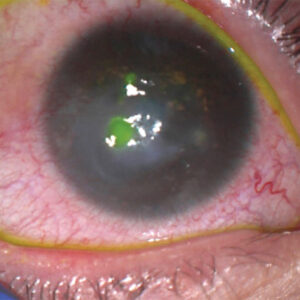ASCRS News: EyeWorld Journal Club
April 2023
by Steven Carrubba, MD, and Sheel R. Patel, MD
New York University Langone Health ophthalmology residents

Immediate sequential bilateral cataract surgery (ISBCS) refers to bilateral cataract extractions performed in the same sitting but as separate, consecutive procedures. Although first performed in the 1950s,1 the practice has become increasingly implemented by some countries (e.g., Finland, Sweden, and Canada) as an alternative to traditional delayed sequential bilateral cataract surgery (DSBCS),2,3 which temporally separates operations between eyes. ISBCS has generated controversy among practitioners. Those in favor cite reduced expenses and fewer office visits for patients and providers, as well as faster overall optical rehabilitation.2 Those opposed argue that the risk of bilateral endophthalmitis and refractive surprises are unjustified.2 The potential benefits of ISBCS have also increased 2interest and inquiry among patients, particularly after the COVID-19 pandemic.4–6 One retrospective study demonstrated that as many as 90% of patients who underwent the procedure would recommend it to their friends and relatives.7 However, areas of uncertainty among patients considering ISBCS include their expected time to visual recovery and functional status immediately following surgery.6 In the article presently reviewed, Kwedar et al. track the short-term postoperative visual acuities of patients who underwent ISBCS to formulate a timeline for visual recovery.
Methods
The authors conducted a retrospective chart review of consecutive patients who underwent ISBCS (emmetropic target) between January and December 2019 at the Harry S. Truman Memorial Veterans’ Hospital. A total of 116 patients (232 eyes) were identified for inclusion. These patients had all originally passed a screening to qualify for ISBCS, which excluded individuals with dense cataracts (i.e., 3+ nuclear sclerotic, white, or posterior polar), prior refractive surgery, extremes of axial length (<22 mm or >25 mm), irregular astigmatism >2 diopters, and certain disease states (e.g., diabetic macular edema, moderate to severe glaucoma, Fuchs dystrophy, uveitis, etc.). The primary endpoint was the uncorrected distance visual acuity (UDVA), measured at office visits on postoperative day 0 (POD0) or 1 (POD1), week 1 (POW1), and month 1 (POM1). Visual acuity was measured via Snellen chart as a fraction relative to 20/20; a given line was counted when a patient could correctly read at least 3 of the 5 letters on that line. These data points were compared with the preoperative corrected distance visual acuity (CDVA) of each or both eyes, which represented the patient’s baseline.
Results
Of the 116 patients (232 eyes) who were studied, 69 (138 eyes) underwent initial postoperative assessment on POD0 and 47 (94 eyes) on POD1. All eyes were subsequently evaluated on POW1 and POM1. Compared to their preoperative CDVAs, 48% (66/138) of eyes by POD0, 79% (74/94) by POD1, and 90% (209/232) by POW1 demonstrated stable or improved UDVAs. Eighty-seven percent (201/232) of eyes achieved these results by POM1. After excluding eyes with baseline vision of 20/30 or better, analysis revealed that 64% (58/90) of eyes by POD0, 87% (61/70) by POD1, 98% (157/160) by POW1, and 95% (152/160) by POM1 demonstrated stable or improved acuities. These results translated to 83% of individuals achieving a stable or improved acuity in their historically better-seeing eye by POD1 (90% by POW1, 89% by POM1), with a median acuity of 20/30 per eye. In fact, 72% (68/94) of eyes achieved a UDVA of 20/40 or better by POD1 and 92% (214/232) by POW1. Nearly all patients (115/116) achieved 20/40 or better acuity in at least one eye by POW1. For those eyes that performed 20/50 or worse by POW1 (18 eyes), five (28%) had known baseline conditions that limited postoperative visual potential.

Source: New York University Langone Health
Discussion
Among patients and providers alike, ISBCS has become an area of worldwide interest as well as a source of debate. Although Kwedar et al. do not comment on the advantages and disadvantages of the surgery itself, they present data that help guide immediate postoperative expectations, which are central to patients considering the procedure. A key takeaway is that compared to preoperative CDVAs, 83% of patients targeted for emmetropia will achieve the same or better UDVA in at least one eye by the first day following ISBCS (90% by week 1), with a median acuity of 20/30 per eye. By postoperative week 1, the acuities of nearly all patients met or exceeded the minimum driving requirements in Missouri and similarly for a majority of states (i.e., 20/40 or better distance vision in at least one eye).8 Limitations of the study included a lack of tabulated patient characteristics and a robust surgical exclusion criteria, which prevented subgroup analysis on any one demographic or of patients with certain ocular comorbidities (e.g., diabetic macular edema). These limitations decreased the study’s generalizability, including for patients whose baseline conditions may predispose them to visually significant complications in the early postoperative period (e.g., Fuchs dystrophy).
While previous studies have demonstrated that ultimate refractive outcomes of ISBCS are comparable to DSBCS,7,9,10 Kwedar et al. provide objective data on the short-term refractive timeline following the former. The data suggest that many patients who undergo ISBCS may expect swift postoperative visual improvement of at least one eye, minimally impacting activities such as driving. Although further studies are indicated for specific populations, the results provide a general basis for conversation when addressing patient concerns regarding the course of visual recovery following ISBCS.
Visual recovery after immediate sequential bilateral cataract surgery at a veterans’ hospital
Kwedar K, et al. J Cataract Refract Surg. 2022;48:1260–1263.
- Purpose: To answer patient questions about the expected timeline for recovery, the objective postoperative visual acuities were reviewed for patients undergoing immediately sequential bilateral cataract surgery (ISBCS).
- Setting: Harry S. Truman Memorial Veterans’ Hospital in Columbia, Missouri.
- Design: Retrospective chart review.
- Methods: All patients who underwent ISBCS in 2019 were evaluated. A total of 116 patients (232 eyes) were studied. Uncorrected distance visual acuity (UDVA) for postop day 0 or postop day 1 (POD0/1), postop week 1 (POW1), and postop month 1 (POM1) were required for study inclusion. Patients with ocular comorbidities were not excluded, though all patients passed an initial screen in order to qualify for ISBCS. Outcome measures included POD0/1, POW1, and POM1 UDVA.
- Results: Postoperative UDVA was stable or improved compared to preoperative corrected VA (CDVA) for 48% (66/138) of eyes on POD0, 79% (74/94) of eyes on POD1, and 90% (209/232) of eyes on POW1. 83% of patients at POD1 and 90% of patients at POW1 had stable or improved VA in at least one eye. 92% (214/232) of eyes had a POW1 UDVA of 20/40 or better. Of the 18 eyes with a postoperative POW1 UDVA of 20/50 or worse, 5 (28%) were known preoperatively to have limited visual potential. 99% (115/116) of patients had at least one eye 20/40 or better.
- Conclusion: Most patients who underwent ISBCS demonstrated meaningful improvement in UDVA compared to preoperative CDVA as early as POD1. These results serve to guide discussion of postoperative expectations with patients interested in ISBCS.
References
- Chan JO, De La Paz P. Bilateral cataract extraction in one sitting. J Philipp Med Assoc. 1952;28:700–705.
- Kessel L, et al. Immediate sequential bilateral cataract surgery: a systematic review and meta-analysis. J Ophthalmol. 2015;2015:912481.
- Grzybowski A, et al. Pros and cons of immediately sequential bilateral cataract surgery (ISBCS). Saudi J Ophthalmol. 2016;30:244–249.
- Naderi K, et al. Attitudes to cataract surgery during the COVID-19 pandemic: a patient survey. Eye (Lond). 2020;34:2161–2162.
- Shah V, et al. Acceptability of immediate sequential bilateral cataract surgery (ISBCS) in a public health care setting before and after COVID-19: a prospective patient questionnaire survey. BMJ Open Ophthalmol. 2020;5:e000554.
- Malcolm J, et al. Immediate sequential bilateral cataract surgery: patient perceptions and preferences. Eye (Lond). 2022. Online ahead of print.
- Sarikkola AU, et al. Simultaneous bilateral cataract surgery: a retrospective survey. J Cataract Refract Surg. 2004;30:1335–1341.
- Driving Restrictions per State. EyeWiki. eyewiki.aao.org/Driving_Restrictions_per_State. Accessed February 20, 2023.
- Sarikkola AU, et al. Simultaneous bilateral versus sequential bilateral cataract surgery: Helsinki Simultaneous Bilateral Cataract Surgery Study Report 1. J Cataract Refract Surg. 2011;37:992–1002.
- Serrano-Aguilar P, et al. Immediately sequential versus delayed sequential bilateral cataract surgery: safety and effectiveness. J Cataract Refract Surg. 2012;38:1734–1742.
Contact
Carrubba: steven.carrubba@nyulangone.org
Patel: sheel.patel@nyulangone.org



